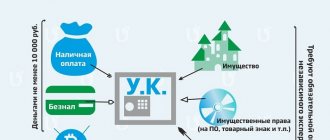Capital is the main tool for a business owner, without which the entrepreneurial activity itself cannot even begin. Own capital consists of heterogeneous parts intended for specific purposes. One of the important and mandatory components of the capital of a legal entity is reserve capital. Unlike other shares of capital, there are some contradictory nuances in its formation, use and accounting.
Below we will consider the legal basis for its formation and application, main functions, connection with retained earnings, as well as the intricacies of accounting entries.
What is included in reserve capital ?
What is reserve capital
Any activity cannot be insured against losses. In entrepreneurship, where the financial issue is the main one, the constant presence of some financial “cushion” for unforeseen situations is especially relevant. It happens that it is impossible to obtain the necessary funds in any other way, while there are certain obligations to counterparties or an urgent need for immediate cash investments.
For these purposes, the enterprise must have a certain insurance fund - a reserve. Thus, reserve capital is a certain part of the organization’s property (or its profit), which performs an insurance function that guarantees the operation of the enterprise without interruptions and compliance with responsibility to counterparties. It consists of retained earnings placed in it.
In a broader aspect, the organization’s reserve fund is a financial source for:
- covering the lack of current assets when forming production reserves, unfinished projects, etc.;
- short-term financial investments.
What accounting data is used when filling out line 1360 “Reserve capital” ?
Purpose of reserve capital:
- compensation for losses if this is not possible from other sources;
- redemption of bonds;
- repurchase of shares of LLC or JSC;
- payment of income to investors (if profits do not allow this);
- dividends on preferred shares;
- compliance with urgent obligations to creditors that cannot be repaid in any other way.
Question: Is it possible to indicate in the charter of an LLC that profits are not distributed among the participants, but are directed to the reserve fund or for the statutory purposes of the company? How to reflect this? View answer
Liabilities and reservations
Another irreplaceable reserve in any modern enterprise is the reserves formed to fulfill obligations. We are talking about the personal savings of unit holders. Such a reserve is needed to cover shortfalls formed during write-offs and overdue loans. Sources for the formation of the reserve, as in the case described earlier, are contributions from unit holders, membership fees and the net profit of the enterprise.
The reserve for securing obligations allows you to set a limit on losses of an individual savings portfolio. The reserve is usually formed at a five percent level relative to the personal investments of participants in the enterprise. For the calculation, indicators for the previous accounting year are taken. The parameters necessary to calculate the maximum reserve amount are reflected in the accounting documentation in the column “Reserves, capital”.
Laws of the Russian Federation on reserve capital
The creation of reserve capital is provided for legal entities - joint stock companies and limited liability companies. But the legislative justification for the formation of this part of equity capital for enterprises of different forms of ownership has significant differences.
Question: How to reflect in the accounting of a joint stock company (JSC) the formation of a reserve fund and its use to cover losses of the current reporting year? In accordance with the charter of the joint-stock company, a reserve fund in the amount of 4,000,000 rubles was formed from the net profit of previous years. Based on the results of the current reporting year, according to accounting data, a loss was received in the amount of 500,000 rubles, which, by decision of the board of directors, documented in the minutes, was covered from the reserve fund. View answer
Reserve capital for JSC
The legislative framework for the functioning of joint stock companies is regulated by the Law on JSC - Federal Law No. 208-FZ of December 26, 1995. Clause 1 of Art. is devoted to reserve capital. 35 of this Law. In it, entrepreneurs-shareholders are legally required to create reserve capital in their enterprise. Its size must be determined by the charter documents of the joint-stock company, but in any case not be less than one twentieth of the total authorized capital.
To form it, you need to annually deduct a certain percentage of profit to this fund (the amount of deductions is also specified in the Charter). It can be anything, but not lower than 5% of net profit, until the fund reaches the value defined in the Charter of the joint-stock company.
The purposes of using the reserve fund of a joint-stock company are strictly fixed in the following closed list:
- covering possible losses of the joint-stock company;
- redemption of bonds;
- share repurchase.
IMPORTANT! All these goals can be achieved through the reserve fund if there are no other sources of financing. It is not permitted by law to use money from the reserve fund for purposes not specified in this list.
Reserve capital for LLC
The Law on LLC (Federal Law No. 14-FZ of 02/08/1998) in Article 30 allows, but does not oblige the founders to create a reserve fund, as well as other funds for certain purposes. The dimensions are not strictly regulated, but it is necessary to streamline them in the statutory documents.
Since the LLC Law does not contain an indispensable obligation to create a reserve fund, the purposes of this part of the capital are not regulated. In this case, paragraph 69 of the “Regulations on Accounting and Accounting in the Russian Federation” may serve as a guide to action, which, in addition to the procedure for distributing funds from the reserve fund among various sub-accounts, lists possible ways of spending it. LLCs can use reserve capital for:
- compensation for losses;
- redemption of bonds;
- redemption of founder's shares;
- increase in the authorized capital.
FOR YOUR INFORMATION! If a JSC or LLC receives foreign investment, its reserve capital must be at least a quarter of the authorized capital, as required by the laws of the Russian Federation.
Specifics of calculations
The described calculation methodology does not allow us to establish a single amount of the reserve fund for all years of the company’s existence. The size of the reserve is floating and is determined by how many arrears have accumulated in a specific time period. The reserve is formed taking into account how large the written-off loans are, for which the arrears exceeded three months. For the calculation, they also take the amount of those loans for which a court decision on compensation was made.
Correct assessment of the reserve fund is required for reporting. From it we can draw conclusions about how large, gross and net, are relative to accounts receivable.
How is reserve capital reflected in accounting?
As already mentioned, reserve capital is included as an integral part in the equity capital of a legal entity (clause 66 of the Accounting Regulations). Paragraph 69 of the same document stipulates that the reserve fund should be displayed separately in the balance sheet. For this purpose, a special account 82 “Reserve capital” is provided, which is a liability. It displays information about the availability of funds in the reserve fund and their dynamics.
Since funds for the reserve fund are taken from retained earnings, the credit of account 82 will function in correspondence with account 84 “retained earnings, uncovered loss.”
EXAMPLE 1. Supercontract LLC declared in its constituent documents the size of its authorized capital at 50 million rubles. – this figure appeared in the documents after the last meeting of the founders on February 15, 2021. The amount of reserve capital as of this date was 2 million 200 thousand rubles. Net profit according to the final documents of 2021 amounted to 12 million rubles.
The amount of reserve capital, in accordance with the requirements of the law and the Charter of Supercontract LLC, should be 5% of the total equity capital: 50 million rubles. X 5% = 2 million 500 thousand rubles. Annual contributions also amount to the statutory 5%. Thus, the net profit of the previous reporting year will contribute 12 million rubles to the reserve fund. X 5% = 600 thousand rubles.
To achieve the size of the reserve fund provided for by the Charter, 2 million 500 thousand rubles are missing. – 2 million 200 thousand rubles. = 300 thousand rubles. They can be accrued from the net profit of 2021, which was decided by the Board of Founders of Supercontract LLC.
The accounting entry was as follows:
15.02.2017
Debit 84, credit 82 – 300,000 rubles. – “Reserve capital has been formed from net profit.”
If the purpose of replenishing the reserve fund is to increase assets, then such an operation must again be reflected under credit 82, but debit 75 must be used - “Settlements with founders”. You can also open additional subaccounts.
EXAMPLE 2. JSC Trayan, represented by its shareholders, decided to increase the value of assets by 6,000,000 rubles, contributing the appropriate funds for this. This decision was reflected in the minutes of the meeting of the joint stock company dated March 13, 2017. Some shareholders transferred the necessary money the next day, March 14, 2017, and the last payment was made on March 21, 2017. This is what the final accounting entry will look like:
14.03. 2021 – 21.03.2017
Debit 51, credit 75 – 6,000,000 rub. – money was received from shareholders for the formation of reserve capital.
21.03.2017
Debit 75, credit 84 – 6,000,000 rub. – reserve capital has been formed through contributions from shareholders.
Target accounting of reserve capital
Since reserve capital (for joint stock companies) can be used exclusively for certain purposes, accounting in each specific case is strictly regulated by the Accounting Rules. The debit of account 82 can be in correspondence with the following accounts provided for in the Account Management Plan:
- 84 “Retained earnings, uncovered loss”;
- 66 “Settlements for short-term loans and borrowings”;
- 67 “Calculations for long-term loans and borrowings.”
Analytical accounting of reserve capital
Unlike accounting, analytical accounting allows you to clarify the areas of use of reserve capital. Reserves formed by enterprises may have different destinations and sources.
- Reserves included in the cost. In accounting, this group of assets is reflected in passive account 96 “Reserves for future expenses.” They are regularly and evenly included in costs, each type of which corresponds to a separate subaccount of this account:
- vacation pay for staff;
- bonuses based on performance results;
- repair of fixed assets;
- warranty repairs and maintenance, etc.
- Reserves included in other income. Initially having different purposes, they are shown in different accounting accounts. When forming them, the amount of the created reserve is subtracted from the cost price, so they will be reflected on the balance sheet at the market value current on the date of entry. These amounts may be written off if they are not used by the beginning of the next accounting period. They are recorded in account 59 “Reserves for depreciation of financial investments.” Such reserves include:
- reserves created by reducing the value of tangible assets - when the market value on the date of entry into the balance sheet is lower than the actual value, the difference forms a reserve;
- depreciation of investment in securities - the same situation as with tangible assets can also arise with securities (purchasing them on the stock exchange at a cost higher or lower than their nominal value, the difference constitutes a reserve).
- Provisions for problematic debt . Problematic (doubtful) debt is a receivable that has not been repaid within the prescribed period and is not secured by guarantee obligations. Such debts can be identified after taking inventory at the end of the year. First you need to assess the debtor's potential ability to repay the debt. The year following the accounting year is allotted for this, during which the amount of debt will be considered a reserve. After this year, the unpaid debt that was the reserve will be listed as debt (5 years are allowed for this) and then will be written off as a loss.
- Additional capital. When an organization is doing well, its capital increases. There is an opportunity to increase assets, including reserve capital. Additional capital may consist of:
- revaluation of enterprise assets (current and non-current);
- the difference between the actual and nominal price of shares used for the authorized capital;
- differences in exchange rates when contributing shares to the authorized capital, if they were made in foreign currency.
ATTENTION! In accounting, when reflecting the balance on account 58 “Financial investments”, it is necessary to subtract the amounts included in the reserve fund for the depreciation of financial investments.
Such a reserve must be taken into account in account 63 “Reserves for doubtful debts” (creation - by debit, writing off and adding reserve balances - by credit).
For accounting of additional capital, account 83 “Additional capital” (credit) and special sub-accounts are intended. A debit can be account 50 “Cash”, 51 “Cash accounts”, 52 “Currency accounts”, etc.
IMPORTANT INFORMATION! The amount included in the reserve as additional capital is usually not subject to write-off, except in cases of an increase in the authorized capital, a write-down of fixed assets after revaluation, or a negative exchange rate difference.
EXAMPLE 3. OJSC “Potrebitel” received the opportunity to increase its authorized capital by placing additional shares in it. At par value, the increase would have been 300,000 rubles, but when selling by subscription, 320,000 rubles were paid for the shares.
Entries in the accounting of OJSC "Potrebitel":
- debit 75 “Settlements with founders”, subaccount “Settlements for contributions to the authorized capital”; credit 80 “Authorized capital”, subaccount “Announced capital” – 300,000 rubles. — the increase in the authorized capital is reflected;
- debit 80 “Authorized capital”, subaccount “Announced capital”; credit 80 “Authorized capital”, subaccount “Subscribed capital” – 300,000 rubles. – subscription to shares is reflected;
- debit 51 “Current accounts”; credit 75 “Settlements with founders”, subaccount “Settlements for contributions to the authorized capital” - 320,000 rubles. – the receipt of funds for the purchased shares is reflected;
- debit 75 “Settlements with founders”, subaccount “Settlements for contributions to the authorized capital”; credit 83 “Additional capital” – 20,000 rubles. – the share premium is reflected (the excess of the actual cost of placing shares over their par value).
Features of using reserve
Financial reserves created in case of loan delinquencies are necessary in order to minimize losses associated with loan write-offs. Loans that are overdue for 90 days or more are written off. The reserve and its value relative to accounts receivable allow us to talk about the amount of the reserve.
Typically, accounting policies prescribe standards, compliance with which guarantees the financial stability of the company. As a rule, reservation is maintained at 8%. Where to get the money to contribute to the reserve is decided by the organization's leaders and management team. All information is recorded in internal official documents, and is also reflected in interim annual reporting. By studying the balance sheet, you can find in it information about the formed reserve and the transactions through which funds were transferred to it in assets. The reserve as a whole and overdue debt separately are indicated. It is also necessary to indicate how large the conditionally written off debt is.
Value of reserve capital
Reserve capital or reserve fund (these concepts are used in the same field) has a rather limited scope of application. Its main function is to compensate for certain losses of the organization. The procedure for spending funds from reserve capital does not increase or decrease the assets of a legal entity: it is only reflected in the composition of equity capital.
The reserve fund is an indirect means of saving the finances of an enterprise, because it protects part of the profit from immediate use at the time of its occurrence, and forces it to “save” this part for a “rainy day” of possible losses, thereby insuring the organization from acute negative consequences.
Features of the provision for obligations
To cover losses caused by overdue loans, it is necessary to create a sufficiently elastic reserve. Delinquencies are grouped based on periods of debt, and money is saved to cover possible losses if any more loans have to be written off in the future.
Fulfillment of obligations requires the creation of a static reserve. Its value is calculated by analyzing how large the savings portfolios are at the end of reporting. The formation of the reserve is determined by the value of such a portfolio, which is closely related to the quality of flow. As the reserve for non-payment of accounts receivable increases, it is also necessary to increase the volume of reserves to fulfill personal obligations.
Reasons for creating a stabilization fund
The processes taking place in the economy and society are inextricably linked with risks, both external and internal. Quite often, risks are imported from the global economy, and in this case their scale may be greater than originally predicted. Due to the impossibility of making absolutely accurate calculations for many interrelated processes, there is a need to create reserve funds, which, if necessary, will be directed to preventive measures or to eliminate adverse socio-economic consequences.
Due to the fact that when planning a budget, force majeure circumstances, which in most cases are difficult to predict, usually do not take into account, reserve resources outside the existing budget are required, which will be used to work to restore the situation in society.
Financial mutual support
Another very important section of reserves formed from the company’s cash reserves is mutual assistance. Such a reserve is created if the board of the joint-stock company issues a corresponding order. The money is spent on credit products, the development of new ideas, and the provision of mutual assistance services, the return on which can only be in the long term.
When issuing an order for the execution of which a reserve is formed, they immediately indicate how large the reserve can be. They limit the limit of transferred amounts and the deadlines within which potentially promising loan products must be met. They also prescribe the maximum duration of waiting for financial returns and the resources through which losses can be compensated if any occur to the enterprise while participating in a loss-making campaign.







